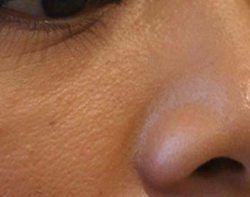What is scarless mole removal
We use radiofrequency (RF) technology to perform a variety of procedures. The RF ablative technique can be used to remove benign moles (benign naevi).
RF ablative technology involves the use of high energy radio waves to remove the lesion, whilst simultaneously minimising any thermal damage to adjacent tissue to ensure minimal scarring.
Who is a suitable candidate
Benign moles evolve over a number of years in a predictable manner. To begin with, the cells reside superficially in the skin (dermo-epidermal junction). As the mole gradually matures over time, the cells clump together and migrate down into the second layer of the skin (dermis). As a result of this maturation process, the mole becomes raised (known now as an intradermal naevus). This intradermal naevus is particularly suitable for RF scarless mole removal.
Other benign lesions that we treat with RF technology include age/wisdom spots (seborrhoeic keratoses), skin tags, benign sweat gland tumours (syringoma) and sebaceous gland overgrowth (sebaceous hyperplasia).
What to expect
Prior to your procedure, a consultation will be required to determine your requirements and review your medical history – both of these factors are an important part of tailoring your treatment plan.
During the procedure, the lesion is anaesthetised with a local anaesthetic. A radiofrequency instrument is then used to safely shape and flatten the lesion. Blood vessels are sealed in the process, hence there is no bleeding. Results are visible immediately. There is typically some degree of redness that occurs after treatment but this fades over time and the final result is usually achieved within a period of 2-3 months.
When using this technique, it is important to avoid over-correction. As a result of this conservative approach, it may sometimes be necessary to perform a touch-up procedure several weeks later.
RF mole removal surgery can be used on any area of the body that unwanted moles or lesions might be present.
How are we unique
To determine whether a skin lesion is suitable for RF treatment, a clinical diagnosis needs to be made. This requires post graduate medical training and experience. Surgical skills are also necessary to ensure the best outcome. We have been performing skin surgery for over two decades (including skin cancer removal surgery) and have used RF as a surgical tool (including for eyelid surgery ‘blepharoplasty’) for well over a decade. As a result, we have built up clinical experience with this treatment modality. This allows us to choose the most appropriate treatment for each lesion and to ensure that serious pathologies, such as skin cancers, are not missed.
Case study 1

Before RF scarless mole removal

2 months after RF scarless mole removal
Case Study 2

Before RF scarless mole removal

18 months after RF scarless mole removal
Do You Have A Question?
Please complete the form below and we will be in touch ASAP

